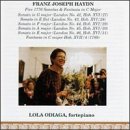Lola Odiaga Plays Haydn
Robin Friedman | Washington, D.C. United States | 11/10/2009
(4 out of 5 stars)
"A friend who knows of my interest in Haydn lent me this fine CD of Lola Odiaga performing five of the six piano sonatas Haydn published as a set in 1776 (missing is the sonata in b minor) together with the short, virtuosic Fantasia in C major dating from 1789. Odiaga is a Peruvian harpsichordist and pianist who studied at Juilliard and at the Hochschule for Musik in Hamburg.
Odiaga is known for the series of CDs of Haydn's keyboard music that she recorded in the mid-1990s, including this disk. She plays on a modern-day replica of a 1790 fortepiano. The instrument has a light, clear sound, with a sound distinctly like a modern piano rather than like a harpsichord. These are exquisite readings with lovely phrasing, ornamentation, dynamics and choice of tempos. The liner notes offer a good introduction to the sonatas.
These five sonatas were published by Hummel in 1776 but Haydn probably composed them considerably earlier. I have recently heard and reviewed a recording of the set on a modern piano performed by Jeno Jando on Naxos, which, as does Odiaga's recording, dates from the mid-1990s. I got another perspective on this infrequently performed music through Odiaga's rendition on the fortepiano.These sonatas are light, appealing works that show the mixture of the popular and the learned that Haydn frequently brought to his piano writing. The five works performed on the CD are all in the major key and all but one of the sonatas is in three movements. Minuets and other dances play a prominent role in these works.
These sonatas exhibit much inventiveness. The G major sonata is a galant work with two contrasting themes in its opening movement, a humorous minuet, and a lively set of variations in its finale. The sonata in E flat major features an opening movement of a highly improvisatory character, including some slow passages that intervene during the course of the allegro, followed by a minuet with a minor-key trio and a comic concluding set of variations. The F major sonata includes a march-like opening movement with sparkling arpeggio passages and other musical surprises in its course. It is followed by the first adagio in this set of sonatas and an expansive concluding minuet.
The remaining two sonatas (in addition to the b minor sonata) are musically more adventurous than their companions. The sonata in A major is played without pause between its two movements, and the variation in the writing gives it the character of a fantasia. The opening moderato includes a wealth of musical detail, including a swinging-horn call passage near the end, and it is linked immediately to a slow sarabande. The work concludes with a complex minuet and six variations which again follow without pause.
The final sonata, in E major, is probably the most familiar of the works on this CD. The expansive and spacious opening movement is followed by an emotional allegretto in the style of a Bach sarabande. The sonata concludes with a mostly lighthearted but surprisingly complex set of variations, including a striking minor key episode.
The beauty and variety of Haydn's keyboard music grows upon me with each hearing, especially by performers new to me. This CD will probably appeal most to listeners who are already familiar with this music and wish to hear an additional interpretation. I was pleased to have the opportunity to hear Odiaga's lovely rendition of these sonatas.
Robin Friedman
"


 Track Listings (15) - Disc #1
Track Listings (15) - Disc #1